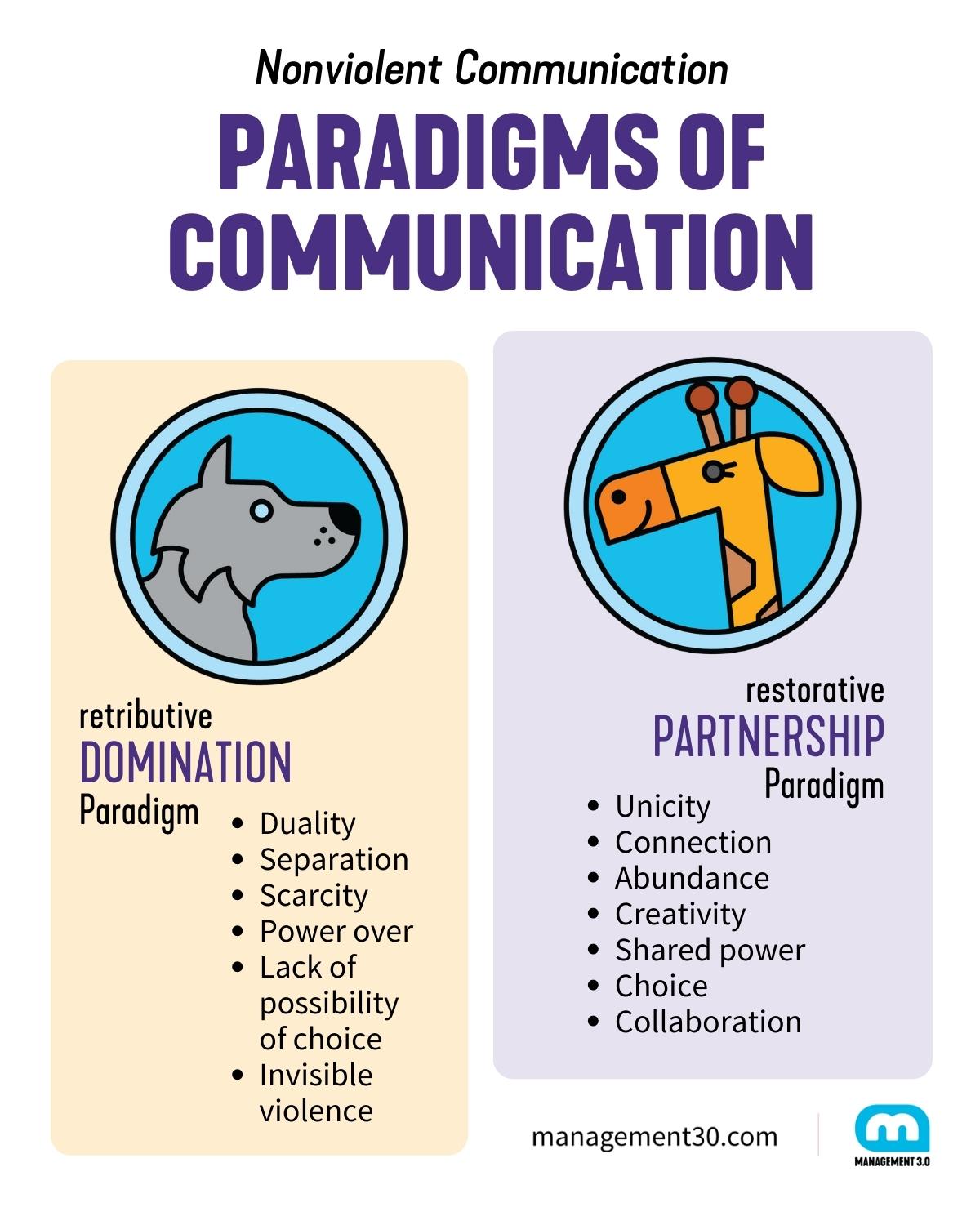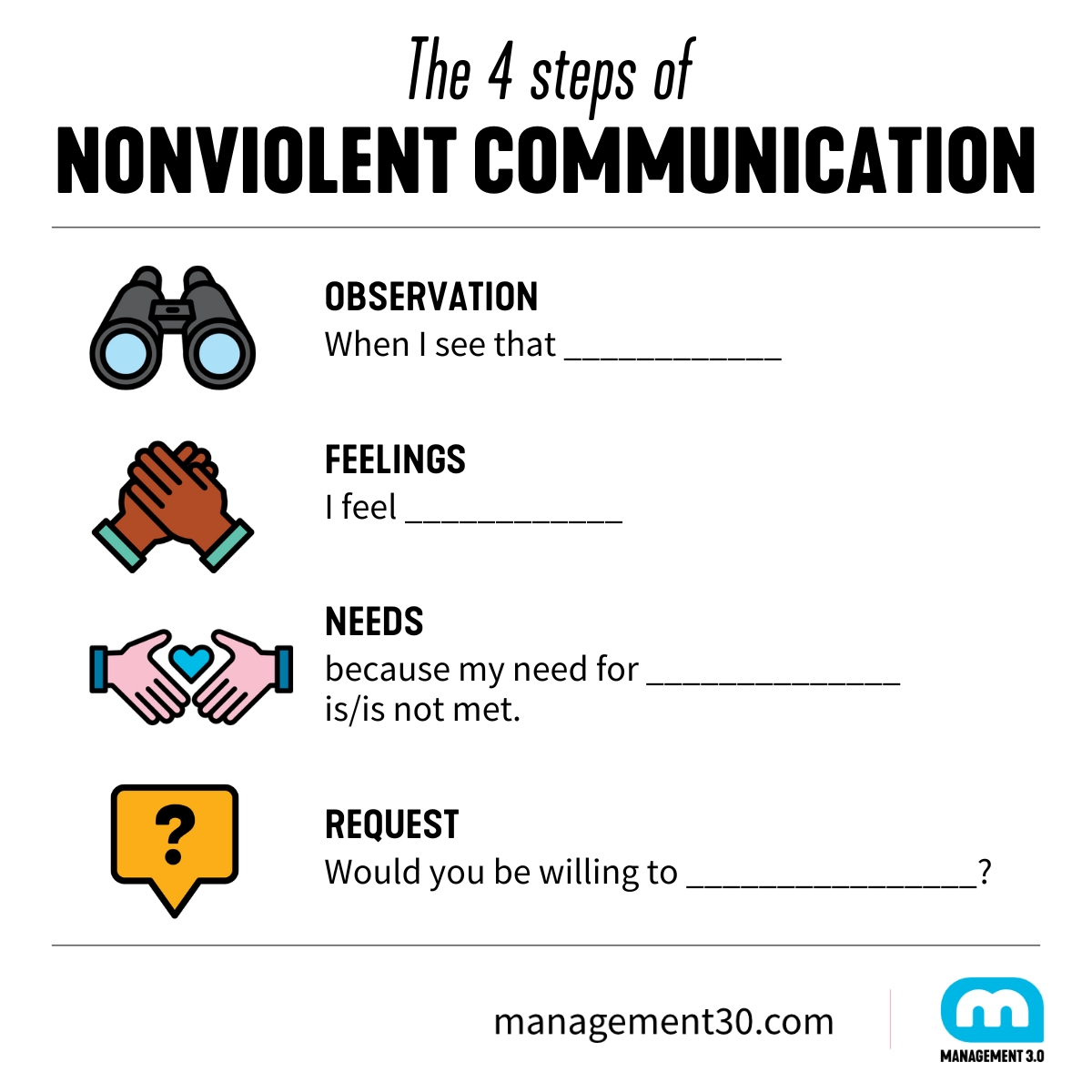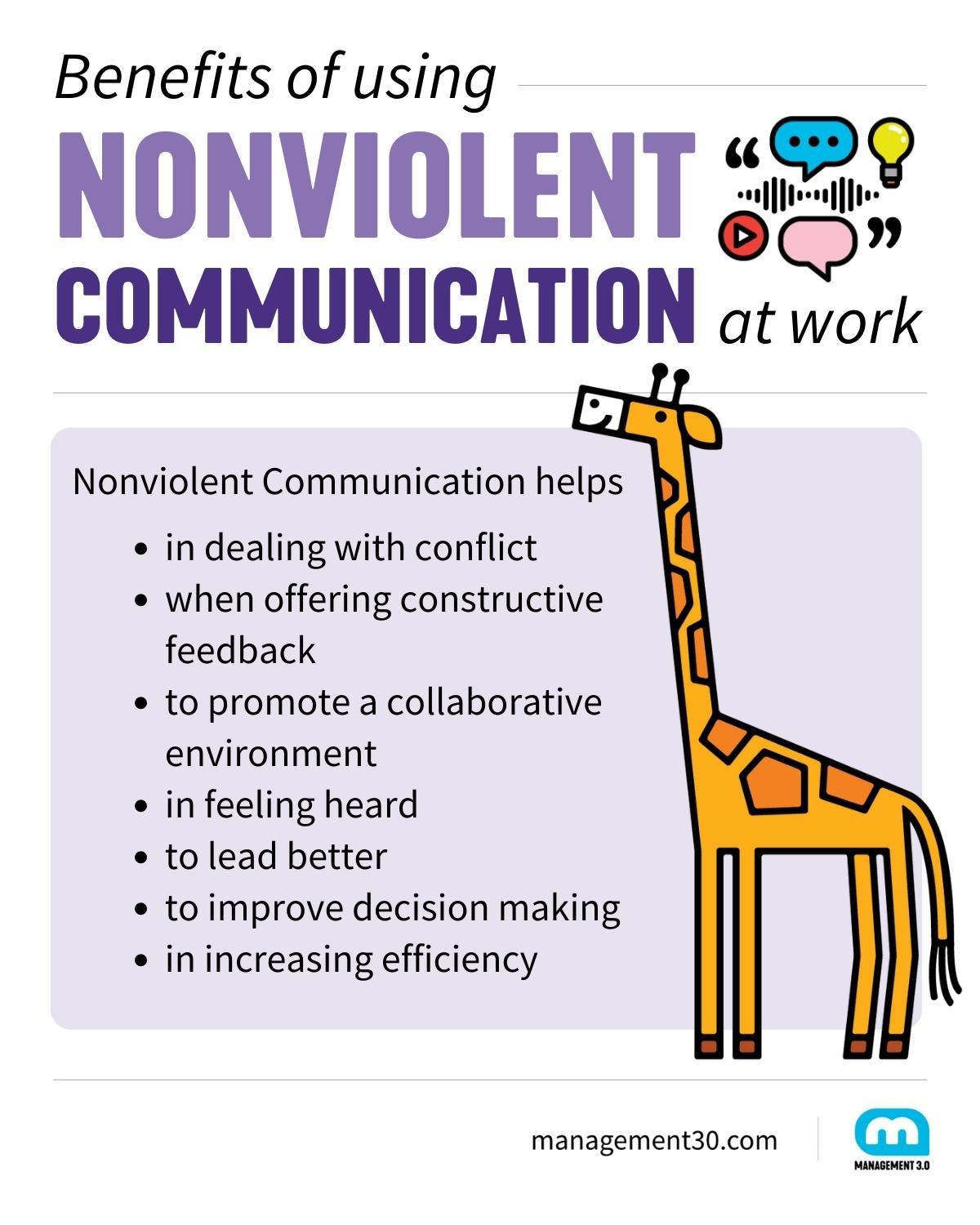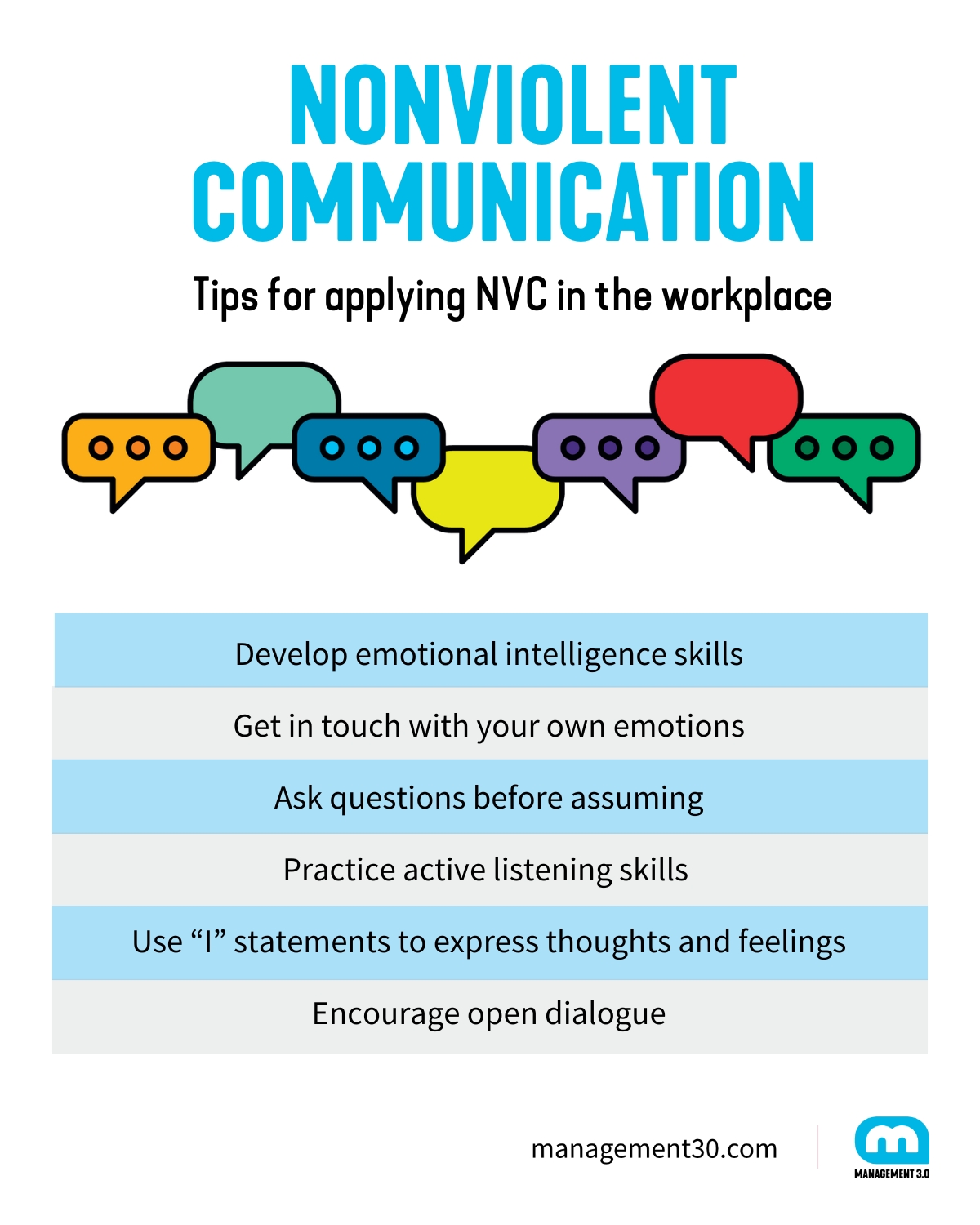Nonviolent Communication (NVC) is an approach to communication developed by Marshall Rosenberg that focuses on empathy, compassion, and understanding. It aims to foster connection and resolve conflicts without resorting to aggression or violence. Management 3.0 Facilitator Fabiana Mello shares the key aspects of applying NVC in the workplace.
- What does Nonviolent Communication mean?
- How does Nonviolent Communication work?
- Benefits of using Nonviolent Communication at work
- How to apply Nonviolent Communication in business
- Tips for applying Nonviolent Communication in the workplace
Have you ever felt uncomfortable offering or receiving feedback about something you need to change? Years ago, a member of the team I lead asked me about the times I was sending emails (usually at 5am). He made it clear that my behavior generated anxiety and concern in the team.
For me, it was like a kick in the stomach. My first impulse was to think of a way to defend myself. I was leading a large cultural transformation project and I was feeling overwhelmed, so sending emails at 5am was my way to try to get things done.
When we receive feedback that sounds like an accusation, our first impulse is to react. In this example, I received feedback that was assertive, but not empathetic. Since I did not want to create conflict, I spent a few days reflecting on this situation. That is when I realized how often I had the same attitude. I was assertive, but not empathetic in the feedback I gave myself. It was as if I had tasted some of my own medicine.
When researching more effective ways of giving and receiving feedback, I heard about Nonviolent Communication. My immediate reaction was: this is not for me; I am not a violent person. But, while it is commonly thought that violent communication involves shouting and aggression, this is not always the case. Speakers can be very nice, but communicate ‘violently’ at the same time, especially in the workplace.
What does Nonviolent Communication mean?
Nonviolent Communication was developed by Marshall Rosenberg. Rosenberg was born in the USA in the 1930s, and specialized in psychology. He was mentored by Carl Rogers – the originator of the person-centered psychological approach. Rosenberg began his professional career as a clinical psychologist, but eventually closed his private practice. He devoted his time to researching new and meaningful ways he could apply his professional training to reduce various forms of violence to disseminate peace-making skills.
In his research, Rosenberg has identified forms of language that block compassion. We will call these forms the Domination Paradigm.
Paradigm of Domination versus Paradigm of Partnership (Jackal vs. Giraffe)
The Domination Paradigm, often referred to as ‘jackal language’, reveals a language full of:
- Diagnoses: which represent labels, judgments, and interpretations. Maybe you have used expressions like: “You’re too lazy.” All depreciation, labeling, criticism, and comparison are forms of judgment.
- Demands: the other person has to do it, otherwise they may suffer a punishment. Demands are actually threats.
- Deserving: wrong deserves to be punished and right rewarded. And then we create the ‘good group’ and the ‘bad group’.
- Denial of Responsibility: we think that there is no choice and that everything has to be a certain way. When we develop this way of thinking, what happens to us is someone else’s fault, and not our responsibility. For example: “I didn’t want to do this, but my manager told me to.”
The paradigm of domination sees communication as a means to achieve certain outcomes or objectives, often at the expense of empathy and understanding. It focuses on winning, being right, and maintaining power dynamics rather than seeking mutually beneficial solutions or fostering connection.

In a paradigm of domination environment, we face:
- Duality: the separation of what should or should not be done has to be clear. This also involves rules and commandments.
- Separation: if our point of view is right, everyone else is wrong.
- Scarcity: there is always a winner and a loser. There is not room for everyone.
- Power conflict: the right people need space to spread their ideas and authority. Others have to obey.
- Power over: becomes one of the greatest human goals, while someone has to fill the submissive role. Order comes from power over others.
- Only way: we always look for the only possible answer, the right answer! A single correct path.
- Lack of possibility of choice: there is only the possibility of commanding or obeying. The system becomes authoritarian and controlling.
- Invisible violence: fear, guilt, and shame. We educate ourselves to continue to obey, and without hesitation, we already blame ourselves.
While the Domination Paradigm takes us away from a happier and more productive work environment, the partnership paradigm makes room for an environment of collaboration, understanding and reciprocity.
Characteristics of the partnership paradigm, often referred to as the ‘giraffe view’ in the context of Nonviolent Communication:
- Unicity: in the opposite way of separating from the dual world, there is no right or wrong, good or bad, but the search for meeting human needs lies behind each action. This I call the “Humanly Correct!”
- Connection: we connect by understanding that we all have the same needs.
- Abundance: there are many possibilities when we realize that we are looking for something beyond the action itself, from there new strategies emerge.
- Creativity: solutions become mutually beneficial and encourage partnerships.
- Shared power: everyone is empowered to create and trust each other, recognizing that we are better together than alone. Competition for power ceases to make sense.
- Choice: when our needs are recognized as well as our differences, choice is a possibility.
- Collaboration: by taking care of everyone’s needs, I am also taking care of my own.
In the paradigm of partnership, communication is seen as a tool for building relationships and addressing conflicts in a compassionate and non-judgmental manner. It emphasizes the importance of active listening, empathy, and expressing oneself authentically. Rather than seeking to control or manipulate others, individuals operating within this paradigm strive to create mutually satisfying outcomes that meet the needs of all parties involved.

Rosenberg identified that certain language characteristics were conducive to a compassionate form of communication, in which all involved had their needs met. It is these characteristics that gave rise to Nonviolent Communication: observations, feelings, needs and requests.
How does Nonviolent Communication work? The four steps of Nonviolent Communication
Based on these four components, Rosenberg created a model for lifeenriching communication that can be highly effective in solving conflict with our family members, friends, coworkers, and ourselves. Yes, also with ourselves!
The way we think influences the way we communicate with others.
The basic outline of the model is the following:
- When I see that ____________
- I feel ____________
- because my need for ______________ is/is not met.
- Would you be willing to ________________?
Observation
Observations represent what actually happened. All too often we mix what we observe, with what we interpret about what we observe, and this creates judgments. On the other hand, an observation is what a video camera can capture.
We know we are in judgment mode when:
- We make generalizations such as “so-and-so is always late for meetings”. Always, never, and every time are generalizations. Instead, choose to say: “you were late for the last 3 meetings.”
- We use adjectives like “you are being stubborn.” Instead, reflect on what makes you think that the person is being stubborn as there may be an observation to uncover.
- We confuse feelings with pseudo-feelings: feelings that are not feelings but words that reflect your thoughts, for example “Roberto disrespected me.”
- We assess the situation, ignoring someone else’s perspective: “this project is going to fail.”
Feelings
Feelings are the second component of Nonviolent Communication. It is interesting to think that we commonly develop a great ability to express our thoughts, but the same does not always happen with feelings.
Developing a vocabulary that allows us to name our feelings and express them clearly makes it possible to establish connections with others.
By allowing ourselves to be vulnerable and express feelings, we contribute to conflict resolution while making our communication more empathetic and assertive.
Needs
Feelings and emotions can be considered messengers of needs. Needs are the stimulus for what we are feeling. What another person does or says is simply a stimulus, but never the cause, of what we feel.
When we communicate from the Domination Paradigm, using judgments, criticisms, diagnoses and interpretations, we are expressing ourselves in a way alienated from our own needs and values.
Needs are not wants. In the context of Nonviolent Communication, Rosenberg refers to universal human needs. That is, we all, to a greater or lesser extent, have the same needs.
Only when we learn to take responsibility for our own feelings and needs will we realize that we cannot meet our own needs at the expense of someone else.
When we fail to recognize our needs and those of others, we get stuck in conflicts over the strategies we use to meet our own needs. Often it is the strategy, and not the need, which is a source of conflict.
Requests
What would you like to ask someone else to make your life even happier and more productive? The clearer your request is, the more likely it will be met. A request should use positive language, stating what you are asking for, rather than voicing outcomes you want to avoid. It is also important to check the recipient’s understanding.
What is the difference between a request and a demand? A request is a way of expressing a need or desire, but recognizing the freedom of the other person to contribute or not to the fulfillment of the request. On the other hand, a demand represents an order that must be fulfilled. It is a request made in a way which indicates that the other person must comply with this demand, without question or discussion. A demand offers no choice to the other party involved.
If you are not willing to take no for an answer, your request is clearly a demand.

How does Feedback Wrap relate to Nonviolent Communication?
If you know the Feedback Wrap practice, you have probably already made correlations with Nonviolent Communication. The Feedback Wrap suggests the following ingredients for good feedback:
| Feedback Wrap | Nonviolent Communication |
| Context | Observation |
| Observations | |
| Emotions | Feelings |
| Values | Needs |
| Suggestions | Requests |
Perhaps you may wonder why, in Feedback Wrap, requests are expressed as suggestions. By offering feedback to someone else, they have the power to decide what they want to do with what you have just shared. A suggestion is a way of encouraging those who receive it to reflect on the content of the feedback and think of alternatives to move forward.
Benefits of using Nonviolent Communication at work
Now that you have an idea of what Nonviolent Communication is about, perhaps you are wondering how this can help you at work. According to Gallup Institute, 76% of people have already experienced symptoms of burnout at work. The lack of clarity in management communication is the third main cause of these symptoms. Nonviolent Communication can help to overcome this, and much more:
- Nonviolent Communication helps in dealing with conflict: like me, many people look to Nonviolent Communication as a way to deal with divergent opinions in a more productive way.
- Nonviolent Communication helps when offering constructive feedback: it is very common to hear complaints about feedback that does not generate value, or worse, causes uncomfortable situations.
- Nonviolent Communication helps to promote a collaborative environment: collaboration is influenced by how we communicate with each other.
- Nonviolent Communication helps in feeling heard: have you ever gone through moments when you seem to speak, but nobody understands what you want to express? This is one of the reasons why people seek Nonviolent Communication.
- Nonviolent Communication helps to better leadership: leaders who practice Nonviolent Communication can create a positive work culture where open and respectful communication is encouraged. This is what impacts people’s motivation and productivity.
- Nonviolent Communication helps to improve decision making: Nonviolent Communication helps ensure that all perspectives are considered during the decision-making process. This can lead to more successful decisions.
- Nonviolent Communication helps in increasing efficiency: clear, direct communication can help avoid misunderstandings and rework, improving overall efficiency and productivity.

In the Learning and Competencies module, which is part of the Management 3.0 Foundation Workshop, Nonviolent Communication is one of the optional exercises to develop team competencies. The way we communicate influences the way we learn, while creating a learning space where people can learn from each other.
How to apply Nonviolent Communication in business
Let us take an example. Imagine that after presenting a new project, you receive the following compliment: “You did a great job!” This sentence does not make it clear what the other thinks ‘great’ work is, how valuable what you’ve accomplished is to them, and most importantly, what you could do to continue receiving praise like this.
Here is how you would phrase this same praise, based on Nonviolent Communication:
“The way you conducted the presentation, creating space for everyone to participate, made me feel very enthusiastic about the project. For me it is very important that everyone collaborates with what lies ahead. It will be amazing if you can continue to create collaboration spaces like this one.”
Do you notice the difference?
But what do you do if you receive a compliment which fails to make clear what you did to receive it? Make requests, using Nonviolent Communication!
For example: “thank you, when you praise me I feel really satisfied, because your recognition is very important to me. Can you give me an example of what I’ve done that I can repeat so that I continue receiving positive feedback like this?”
Expressing feelings in the workplace does not mean sharing your entire story, your personal challenges and deepest beliefs. You could do that, depending on the context, but that is not what Nonviolent Communication is for. It is about sharing what we feel and need in light of what we observe, and this requires full attention.
Nonviolent Communication is also a way of connecting human needs and organizational values. According to Richard Barrett, organizational values must be authentic and based on a deep understanding of team and stakeholder needs. These values should be applied in a consistent and integrated way in all areas of the company, from strategy, to people, and process management practices.

Tips for applying Nonviolent Communication in the workplace
As I have highlighted, Nonviolent Communication is a path of self-development, at least it was for me. I will tell you where I started, and maybe it can help you:
- Develop emotional intelligence skills. There is no way to notice your own feelings if your mind is stuck in your own thoughts. For me, meditation practices help, as well as being in nature or doing a physical activity that requires focus and attention.
- Get in touch with your own emotions. When I am faced with situations that make me uncomfortable, I try to understand where the emotion comes from, what need of mine is behind how I feel. I cannot always do this while the situation is happening, so I keep a journal, and write about it. Some questions I ask myself are: what was the event? How did I feel? What thoughts came up? What need of mine was not met in this situation? What could I have asked for myself or for the other person?
- We often react to the other person according to our interpretation, that is, our own thoughts. Before assuming what the other thinks or feels, ask questions!
- Practice active listening skills to understand the perspectives and feelings of others. Pay attention to both verbal and non-verbal cues, and make an effort to create a safe and supportive environment for open communication.
- Use “I” statements to express thoughts and feelings without blaming or accusing others. This approach promotes personal responsibility and avoids triggering defensiveness or resistance in others.
- In situations where conflicts arise, encourage open dialogue, where all parties are given an opportunity to express their concerns and needs. Facilitate discussions that aim to find mutually satisfying resolutions rather than focusing on blame or punishment.
Keep in mind: leaders and managers play a crucial role in promoting Nonviolent Communication in the workplace. Lead by example and model the principles of Nonviolent Communication by actively listening, demonstrating empathy, and promoting a culture of open and respectful communication.

I want to end this article by emphasizing one thing: remember that just because I write about this topic, facilitate workshops and practice groups this does not mean that my way of communicating is always compassionate. Nonviolent Communication depends on our conscious intent. Here I follow the path of practice, developing a form of communication that can contribute to Rosenberg’s key objective: developing a culture of peace.
Implementing Nonviolent Communication in the workplace takes time and effort. It requires a commitment from all members of the organization to create a culture of empathy, understanding, and effective communication.

